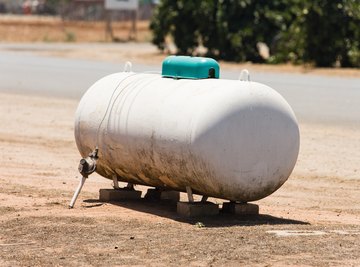
Natural gas is an abundant and integral part of the world’s energy supply. When burned, it is one of the cleanest and most powerful forms of energy available. It allows us to cook, use electricity and perform convenient daily tasks. Though it primarily consists of methane, there are other hydrocarbons that contribute to the makeup of natural gas. After natural gas is refined, those individual hydrocarbons can be used as various sources of energy.
Methane
Natural gas is stripped down to methane before being used by consumers. It is the most abundant component of pure natural gas, is highly combustible and can be used for a wide range of energy purposes. Before methane can be burned, it first has to be stripped from the natural gas that’s found in oil wells, gas wells and condensate wells. Once processed from the natural gas, it is used for generating electricity through gas and steam turbines. It is also sent to homes through pipelines where it’s used for cooking, heating, air conditioning and other important home activities.
Ethane
Ethane is the next most abundant component of energy found in natural gas. It is a hydrocarbon and a byproduct of petroleum refining. With a higher heating value than methane, it is used in several ways after being isolated from natural gas. Once separated from natural gas, ethane is often used to produce ethylene and polyethylene products. In turn those are used to produce packaging, trash liners, insulation, wire and other consumer products.
Propane
Propane is an abundant energy source found in natural gas and is processed in gas or liquid form. Often found in pipeline gas, propane can be used for a variety of purposes. Frequently, it is used for fueling engines, cooking with stoves and for central heating within the home or larger buildings. Propane is also used for many barbecue grills due to its high-energy output and portability. Some buses and larger vehicles are fueled on propane, and many homes also use the gas for fueling the furnace, water heaters and other essentials.
Butane
Found in natural gas, butane is not as abundant as other hydrocarbons, but it is still a viable energy source and can be used for a variety of purposes. Isolated during natural gas processing, butane makes up around 20 percent of natural gas composition. It is often a component in automobile gas. Refrigeration units and lighters also use a large amount of butane as fuel. Aerosol cans use butane as a propellant, but this has been flagged as harmful to the environment.
References
About the Author
Residing in Nashville, Tenn., Kiley Mitchell has been writing topical articles and SEO copy since 2002. He has done work for the Wyndham hotel chains and has written about topics including travel, music, online marketing, business, health and literature. Mitchell holds a Bachelor of Arts from Indiana University in Bloomington.
Photo Credits
Jupiterimages/Photos.com/Getty Images
